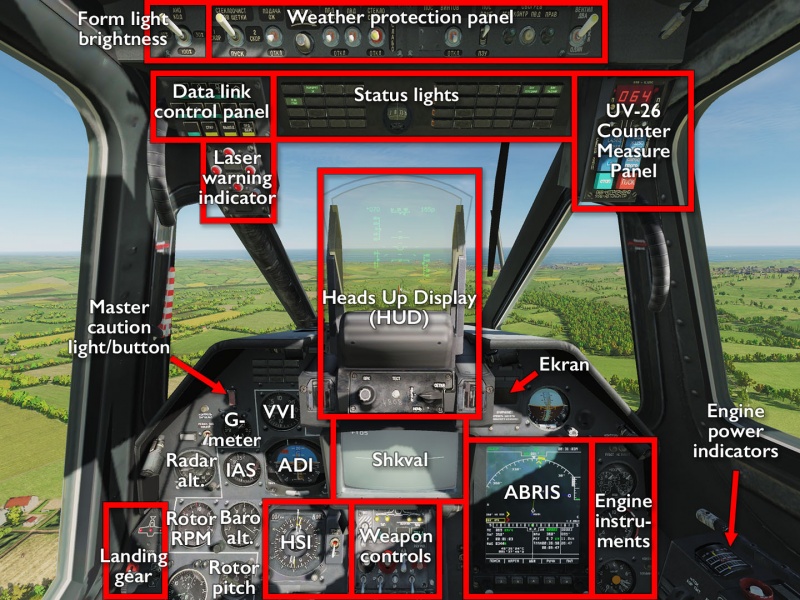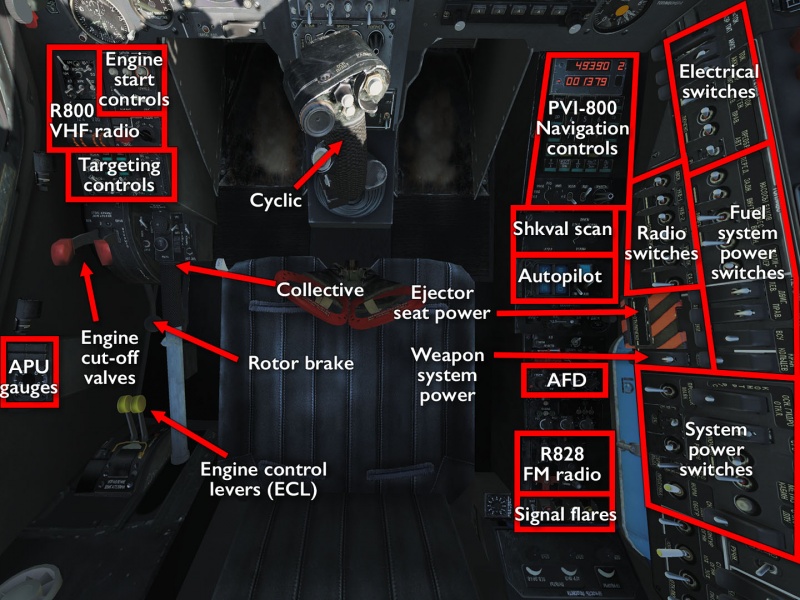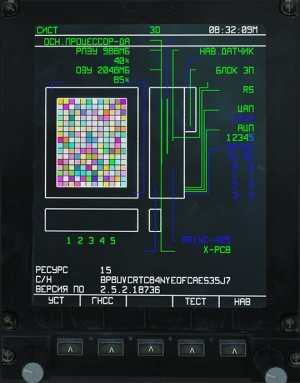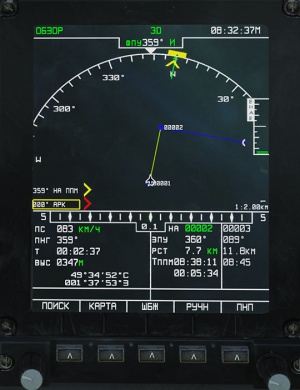Ka-50 Black Shark 2: Difference between revisions
m (→�) |
mNo edit summary |
||
| Line 1: | Line 1: | ||
{{RightImg|https://www.digitalcombatsimulator.com/upload/iblock/4e7/12.jpg}} | {{RightImg|https://www.digitalcombatsimulator.com/upload/iblock/4e7/12.jpg}} | ||
The Black Shark was the first module to be released for what was later to become [[Digital_Combat_Simulator|DCS]]. Alongside the [[A-10C_Warthog|A-10C]] it was released as a separate simulator when it became clear that the old [[Lock_On:_Modern_Air_Combat|LOMAC]] game engine would not be a suitable basis for the sim. A while later, both games were re-envisoned as modules in a shared framework — DCS World — and Black Shark was revisited and re-relased as DCS: Black Shark 2. | |||
The “Black Shark” in question is the single-seater Ka-50 attack helicopter, with the distinctive Kamov coaxial rotors — an advanced scouting and anti-tank helicopter that does away with the usual set-up of having flying, navigation, and weapons employment be split between a pilot and a co-pilot. | |||
{{tocright}} | {{tocright}} | ||
== Features == | == Features == | ||
To accomplish this feat, the Ka-50 comes equipped with a string of helper systems to aid and reduce the workload of the pilot: | |||
* An advanced autopilot that manages engines and rotors to varying degrees — from simply giving acting as stabilisers and providing cyclic input cues, all the way to full flight automation and target- and route following. | |||
* The Shkval electro-optical targeting system, including head-mounted aiming and automated target search. | |||
* Laser-guided Vikhr and Kh-25ML missiles. | |||
* A built-in adjustable 30mm auto cannon with automated aiming. | |||
* Additional dumb weapons including free-fall bombs, cluster-munition dispensers, UPK-23 cannons, and S-13 and S-8 rockets. | |||
* ABRIS on-board GPS-based navigation and PVI800 INS navigation systems with data linking. | |||
* …and dual rotors. This cannot be stressed enough. | |||
Comes with the built-in campaigns [[Built-in_Campaigns#Deployment|Deployment]], [[Built-in_Campaigns#Georgian_Oil_War|Georgian Oil War]], and [[Built-in_Campaigns#Operation_Medvedev_II|Operation Medvedev II]]. | Comes with the built-in campaigns [[Built-in_Campaigns#Deployment|Deployment]], [[Built-in_Campaigns#Georgian_Oil_War|Georgian Oil War]], and [[Built-in_Campaigns#Operation_Medvedev_II|Operation Medvedev II]]. | ||
== Flying the Ka-50 == | == Flying the Ka-50 == | ||
The Ka-50 is often compared to the [[A-10C_Warthog|A-10C]] because both are complex, systems-heavy, single-pilot attack aircraft. However, they are in many ways each other's exact opposites: the A-10C is easy to fly, but difficult to employ because of its complex set of sensors and weapons delivery modes. The Ka-50 has a very standardised way of delivering weapons, but is not easy to fly. | |||
At the same time, the Ka-50 is often said to be the easiest of the DCS helicopters because of how much help the pilot gets from the built-in systems. Both perspectives are entirely true and accurate at once. The Ka-50 ''is'' easy to fly because the automation takes care of almost all the flying, but it is ''also'' difficult to fly exactly because you may end up fighting with that automation a lot unless you understand what it does and when and how it should be overridden or left alone. There is a complex interplay between stabilisation modes and trimming, all of which operate very differently than any other helicopter or fixed-wing airplane. | |||
=== Autopilot modes === | === Autopilot modes === | ||
In truth, you do not so much ''fly'' the Ka-50 as ''program'' it, somewhat (but not entirely) like a fly-by-wire system in a regular airplane, but with far more authority and memory in relation to the pilot's inputs. New pilots that end up fighting the autopilot generally do so because one or more control channels have been left on with instructions that conflict with what the pilot actually wants, or because of increasingly out-of-whack trim settings. | |||
Revision as of 03:06, 23 June 2018
The Black Shark was the first module to be released for what was later to become DCS. Alongside the A-10C it was released as a separate simulator when it became clear that the old LOMAC game engine would not be a suitable basis for the sim. A while later, both games were re-envisoned as modules in a shared framework — DCS World — and Black Shark was revisited and re-relased as DCS: Black Shark 2.
The “Black Shark” in question is the single-seater Ka-50 attack helicopter, with the distinctive Kamov coaxial rotors — an advanced scouting and anti-tank helicopter that does away with the usual set-up of having flying, navigation, and weapons employment be split between a pilot and a co-pilot.
Features
To accomplish this feat, the Ka-50 comes equipped with a string of helper systems to aid and reduce the workload of the pilot:
- An advanced autopilot that manages engines and rotors to varying degrees — from simply giving acting as stabilisers and providing cyclic input cues, all the way to full flight automation and target- and route following.
- The Shkval electro-optical targeting system, including head-mounted aiming and automated target search.
- Laser-guided Vikhr and Kh-25ML missiles.
- A built-in adjustable 30mm auto cannon with automated aiming.
- Additional dumb weapons including free-fall bombs, cluster-munition dispensers, UPK-23 cannons, and S-13 and S-8 rockets.
- ABRIS on-board GPS-based navigation and PVI800 INS navigation systems with data linking.
- …and dual rotors. This cannot be stressed enough.
Comes with the built-in campaigns Deployment, Georgian Oil War, and Operation Medvedev II.
Flying the Ka-50
The Ka-50 is often compared to the A-10C because both are complex, systems-heavy, single-pilot attack aircraft. However, they are in many ways each other's exact opposites: the A-10C is easy to fly, but difficult to employ because of its complex set of sensors and weapons delivery modes. The Ka-50 has a very standardised way of delivering weapons, but is not easy to fly.
At the same time, the Ka-50 is often said to be the easiest of the DCS helicopters because of how much help the pilot gets from the built-in systems. Both perspectives are entirely true and accurate at once. The Ka-50 is easy to fly because the automation takes care of almost all the flying, but it is also difficult to fly exactly because you may end up fighting with that automation a lot unless you understand what it does and when and how it should be overridden or left alone. There is a complex interplay between stabilisation modes and trimming, all of which operate very differently than any other helicopter or fixed-wing airplane.
Autopilot modes
In truth, you do not so much fly the Ka-50 as program it, somewhat (but not entirely) like a fly-by-wire system in a regular airplane, but with far more authority and memory in relation to the pilot's inputs. New pilots that end up fighting the autopilot generally do so because one or more control channels have been left on with instructions that conflict with what the pilot actually wants, or because of increasingly out-of-whack trim settings.
Cockpit overview
Getting into the air
Shooting something
Shkval
Weapon selection
ABRIS
Links and files
- Tippis' Checklist (see also kneeboard mods).
- Chuck's Ka-50 guide.
- DCS: Black Shark 2 in the DCS shop.
Related DCS modules
- Republic for Ka-50 campaign.
More information
- Kamov Ka-50 on wikpedia.
- Ka-50 HOKUM / Black Shark / Werewolf on globalsecurity.org
| DCS World | |
|---|---|
| Helicopter modules (full sim) |
Ka‑50 Black Shark 2 · Mi‑8MTV2 Magnificent Eight · Mi‑24P Hind · SA342L, M, Mistral, and Minigun Gazelle · UH‑1H Huey |






